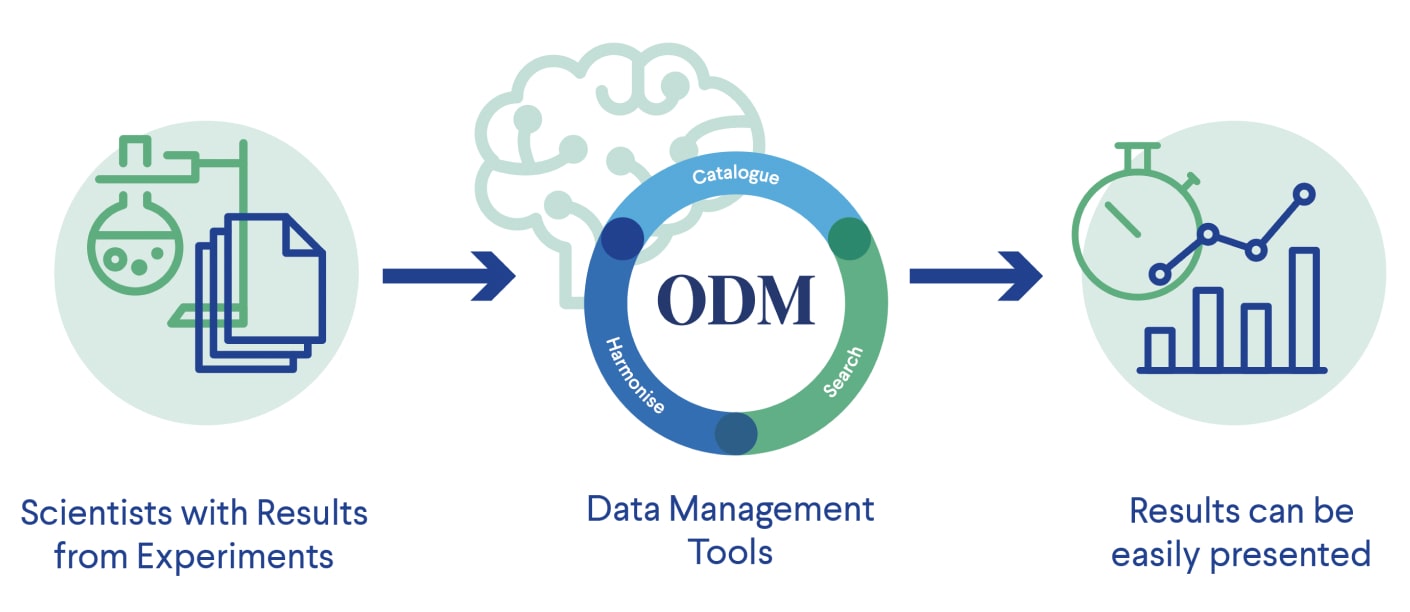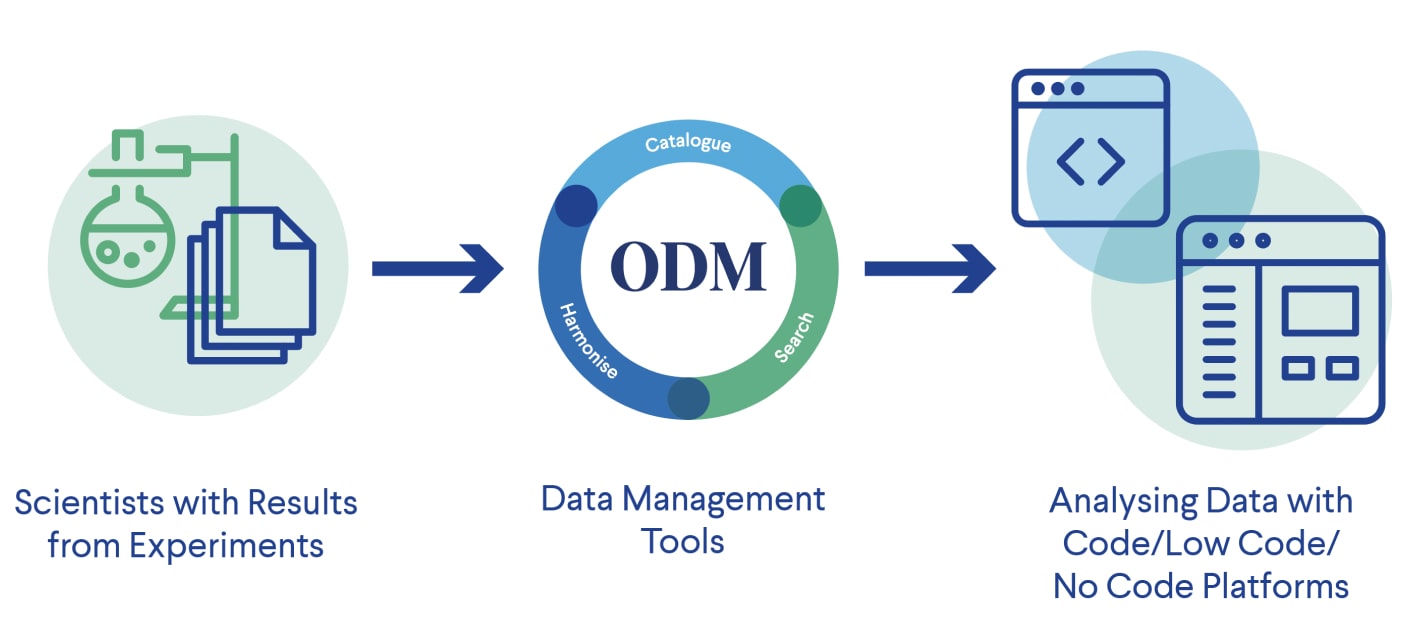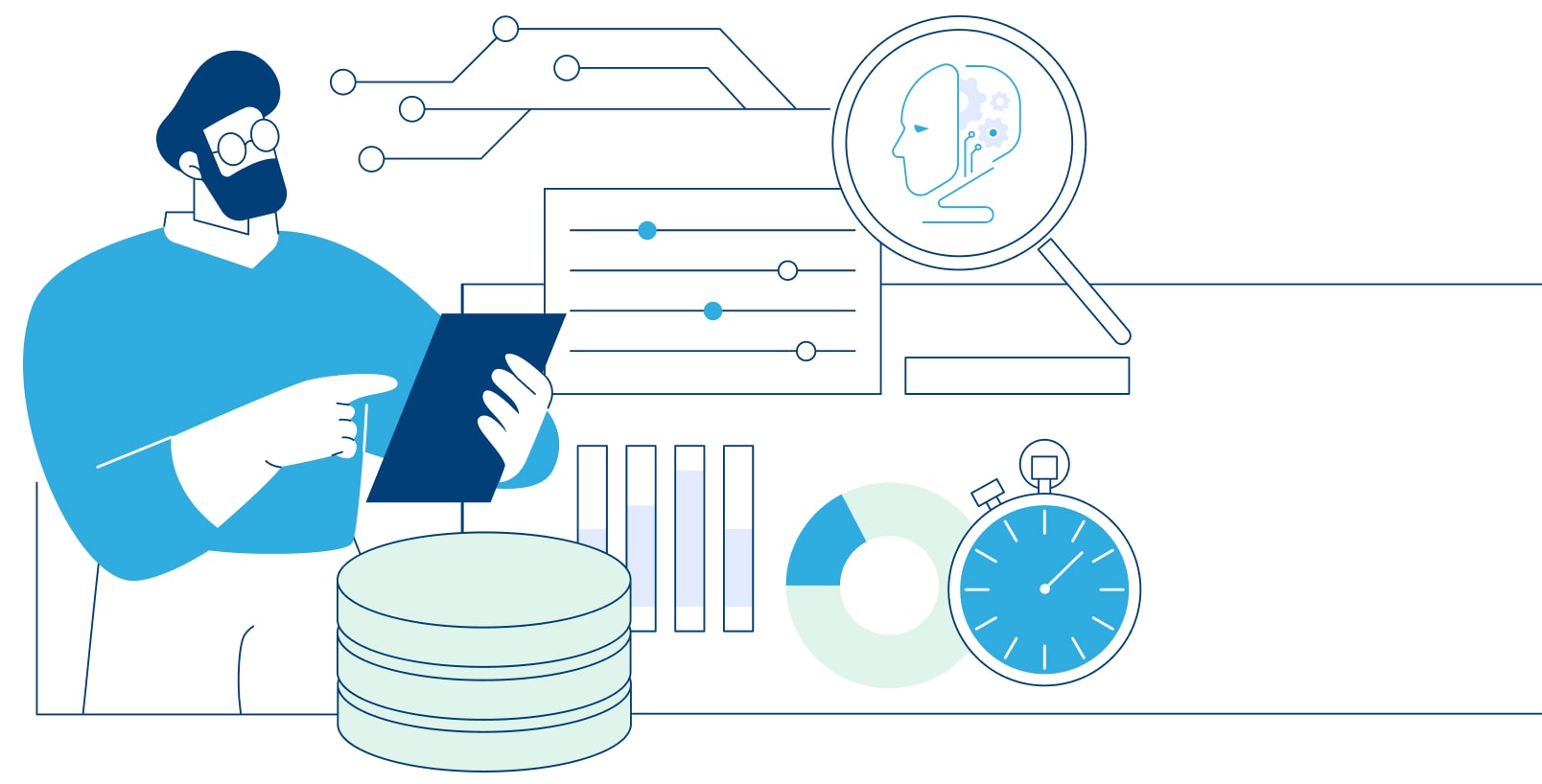Introduction
In the modern era, data has become a crucial part of our lives. Data provides the required information to drive decision-making, foster innovation, and improve life quality. The amount of data obtained through various sources is growing exponentially. The total amount of data created, captured, copied, and consumed globally is forecast to increase rapidly, reaching 64.2 zettabytes in 2020. Over the next five years, global data creation is projected to grow to more than 180 zettabytes (1). It is estimated that approximately 30% of the world’s data is being generated by the healthcare industry, and it is projected that it will reach 36% by 2025 (2).
The exponential growth of data production, coupled with the need for data quality and flexible storage solutions, presents significant challenges for both users and organizations. In this context, several resources have been developed to facilitate the Findability, Accessibility, Interoperability, and Reusability (FAIR) principles, promoting good scientific practices for data and resources (3). Effective Data Management (DM) is crucial to ensure the appropriate collection, processing, and storage of data while protecting users' and consumers' rights (4).
At Genestack, we specialize in optimizing the DM process. With our Open Data Manager (ODM) platform, complex data can be easily curated and harmonized, allowing delivery quickly at scale.
Here, we explore the main trends in data management and how Genestack is keeping pace with these advancements.
Current Trends in Data Management
As we delve into the future of data management, several key trends are shaping the landscape. These innovations drive how organizations manage, process, and secure their data, ensuring they remain agile and competitive in a rapidly evolving digital world. Below, we explore the most significant trends in data management today:
- Revolutionizing Data with AI and Machine Learning
- The Multi-Cloud and Hybrid-Cloud Advantage
- The Emergence of Lakehouses: Combining the Best of Data Lakes and Warehouses
- Strengthening Data Security and Privacy
- Real-Time Data Integration: The Need for Speed
- Low-Code/No-Code Movement: Democratizing Data Integration
- Advanced Metadata Management and Data Governance: Ensuring Data Quality and Compliance

Navigating Data Management Trends with Genestack's ODM: From AI Integration to Multi-Cloud Strategies
Revolutionizing Data with AI and Machine Learning
Reducing the need for manual data management has become a key goal. AI and machine learning (ML) can improve data quality, processing, and governance, enabling real-time analysis (5, 6). AI can efficiently handle data integration, synchronization, and migration, enhancing consistency and using custom algorithms to predict and prevent data quality issues (7, 8).
At Genestack our services team leverages AI and ML to process massive amounts of unstructured data, providing relevant insights through advanced data visualization. Our recent work emphasizes the role of Large Language Models (LLMs) in life sciences. LLMs can process and understand complex biological data, enabling predictive modeling, pattern recognition, and anomaly detection (9). By integrating AI and ML, we can create automated pipelines for large-scale bioinformatics workflows, reducing manual intervention and speeding up research timelines.
The importance of data curation cannot be overstated when utilizing AI and ML. Properly curated data ensures that AI models are trained on accurate and relevant datasets, enhancing their reliability and effectiveness (10). At Genestack, we emphasize the dos and don'ts of using LLMs in data curation to maintain high data quality and derive meaningful insights (Learn more here).

AI-Powered Metadata Management: Revolutionizing Data Curation and Analysis
The Multi-Cloud and Hybrid-Cloud Advantage
In today's digital landscape, flexible cloud system options that comply with local regulations are essential. While relying on a single cloud provider can offer agility and innovation, it also comes with limitations that may pose challenges for data management (6). As a result, multi-cloud and hybrid-cloud computing are increasingly popular trends, with organizations adopting these strategies to gain flexibility, reduce vendor lock-in, and enhance business continuity.
A hybrid-cloud approach combines the power of public cloud resources with the security of private cloud infrastructure, allowing data and applications to be shared between them. This enables businesses to maintain sensitive workloads on a private cloud while leveraging public cloud resources for non-sensitive tasks (6). Meanwhile, a multi-cloud strategy addresses data management challenges by distributing data and applications across multiple platforms, ensuring redundancy, availability, and enhanced security (6).
Both hybrid and multi-cloud strategies emphasize flexibility, scalability, and the ability to leverage diverse cloud resources to meet organizational needs. According to the 2024 State of the Cloud Report by Flexera (7), 87% of organizations worldwide have implemented a multi-cloud strategy, while 72% combine this with a hybrid-cloud approach.
Genestack is actively involved in these trends by providing advanced, cloud-agnostic data management and bioinformatics solutions. Our ODM platform integrates seamlessly with various cloud environments, enabling life sciences organizations to leverage hybrid-cloud architectures for secure, scalable, and efficient data processing across multiple cloud providers. This flexibility allows Genestack's clients to optimize costs, performance, and regulatory compliance by utilizing the cloud services best suited to their specific needs.
The Emergence of Lakehouses: Combining the Best of Data Lakes and Warehouses
Data lakes, such as AWS and Azure, store diverse data in its raw form, whereas data warehouses like Google BigQuery and Amazon Redshift require data to be cleaned and structured before storage (12). Data lakehouses merge these benefits, breaking down data silos, enabling real-time data processing, and supporting advanced analytics and AI (13).
At Genestack, we recognize the necessity of data lakehouses for managing large amounts of raw data while providing structure and data management functions. Platforms like Google Big Lake and Databrick Lakehouse exemplify this trend, helping organizations unlock data potential, accelerate innovation, and gain a competitive edge. By working with our customers and partners we provide integrated solutions for all data management and prevent data lakehouses from becoming yet another form of silo.
Strengthening Data Security and Privacy
Data privacy and security have evolved into top priorities. With the growing volume of data, and complexities introduced by remote work, IoT (Internet of Things) devices, and multi-cloud environments, the prevalence of ransomware attacks and data breaches has increased (14). The European Union's Digital Services Act and Digital Markets Act further emphasize the importance of protecting users' rights (15). In response, users expect stronger data privacy measures in data integration solutions.
At Genestack, we take security and privacy seriously. As an ISO27001 accredited company, we not only ensure compliance with regulations like GDPR and HIPAA but also ensure the security of your data above and beyond regulatory requirements. By implementing robust data governance frameworks to protect sensitive biological data and adopting encryption technologies, tokenization, and secure data-sharing methods we aim to help our customers enhance data privacy and security.
Real-Time Data Integration: The Need for Speed
With IoT and edge computing on the rise, real-time data processing and analytics are increasingly in demand. Real-time integration enables businesses to quickly respond to market changes and improve customer experiences (8). This capability is crucial for industries such as healthcare, banking, and manufacturing (18). Thus, real-time data integration is becoming not just a trend but also a necessity for companies to make data-driven decisions.
While Genestack’s ODM platform is currently focused on advanced data management, bioinformatics, and multi-omics data integration, its flexible, cloud-agnostic design positions it well for future integration with real-time data processing tools. By leveraging this flexibility, Genestack can help life sciences organizations explore real-time data integration solutions tailored to their specific needs, especially in areas where immediate data processing and analysis are crucial, such as clinical trials, genomics, and personalized medicine.
Low-Code/No-Code Movement: Democratizing Data Integration
Low-code and no-code (LC/NC) platforms enable developers and non-developers to create applications with minimal or no coding. This accelerates software development, reduces costs, and allows IT teams to focus on complex tasks (19). By 2025, 70% of apps are expected to employ LC/NC technology In the rapidly evolving technology landscape, the LC/NC paradigm is a response to the need for efficiency and accessibility (20).
In the rapidly evolving technology landscape, the LC/NC paradigm is a response to the need for efficiency and accessibility.
At Genestack, we embrace the LC/NC movement to make data management more accessible, efficient, and collaborative, empowering users to harness the power of data. The Genestack ODM platform offers intuitive interfaces and user-friendly tools that allow scientists and researchers to manage, analyze, and visualize complex biological data without needing to write code. By simplifying the process of creating custom workflows and automating data tasks, Genestack enables life sciences professionals to focus on their research rather than the technical intricacies of data management, aligning with the broader LC/NC movement.

Low-Code/No-Code Platforms: Simplifying Advanced Data Management with User-Friendly Interfaces
Advanced Metadata Management and Data Governance: Ensuring Data Quality and Compliance
Metadata provides clarity, context, and structure to data, making it a key component for organizational decisions. As data ecosystems grow in complexity, the importance of managing metadata becomes increasingly critical. Implementing comprehensive metadata management strategies ensures data is well-documented, easily discoverable, and reusable. This includes tracking data provenance, lineage, and context (6).
Data governance is another crucial element for maintaining data quality, consistency, and reliability. Implementing clear policies and standards for data cataloging, lineage, and stewardship is essential for robust data governance. Automation of data governance processes is becoming increasingly important as organizations seek to improve data quality and control data access.
Effective data governance frameworks help organizations navigate the complexities of regulatory compliance, such as GDPR and HIPAA. They ensure that sensitive data is protected, and data handling practices are transparent and accountable. At Genestack, we emphasize the importance of comprehensive data governance to protect sensitive biological data, enabling our clients to maintain data integrity, security, and compliance.
By investing in advanced metadata management and robust data governance frameworks, organizations can leverage their data assets more effectively, ensuring high data quality and enabling data-driven decision-making. These practices will be critical in navigating the challenges and opportunities of the data-driven era.
Conclusion: Embrace the Future of Data Management with Genestack
In conclusion, the data management landscape is rapidly evolving, with new trends and technologies shaping the way organizations handle their data. From AI and machine learning to multi-cloud strategies, data lakehouses, enhanced security measures, and innovative approaches like data fabric and data mesh, these trends are redefining how we manage, process, and leverage data.
For a company like Genestack, staying at the forefront of these trends is not just a strategic advantage; it's essential for delivering cutting-edge bioinformatics solutions and services. Our commitment to integrating advanced technologies, ensuring robust data governance, and fostering a collaborative approach to data management; positions us as a leader in the industry. At Genestack, we understand the importance of data curation and the role of AI in life sciences, as highlighted in our recent publications. By leveraging these advancements, we help our clients unlock the full potential of their data, accelerate innovation, and maintain a competitive edge.
Want to learn more? Visit www.genestack.com to explore how Genestack can help your organization navigate the complexities of modern data management.
Alternatively, contact us to discuss how our solutions can meet your specific needs and drive your data strategy forward.
Together, let's embrace the future of data management and unlock new possibilities for your business.
References
- Taylor, P. (2023). Data growth worldwide 2010-2025. Statista. https://www.statista.com/statistics/871513/worldwide-data-created/
- RBC Capital Markets. (2023). RBC Capital Markets. Navigating the Changing Face of Healthcare Episode. https://www.rbccm.com/en/gib/healthcare/episode/the_healthcare_data_explosion
- Wilkinson, M. D., Dumontier, M., Aalbersberg, Ij. J., Appleton, G., Axton, M., Baak, A., Blomberg, N., Boiten, J.-W., da Silva Santos, L. B., Bourne, P. E., Bouwman, J., Brookes, A. J., Clark, T., Crosas, M., Dillo, I., Dumon, O., Edmunds, S., Evelo, C. T., Finkers, R., … Mons, B. (2016). The FAIR Guiding Principles for scientific data management and stewardship. Scientific Data, 3(1). https://doi.org/10.1038/sdata.2016.18
- Foote, K. D. (2023, December 26). Data management trends in 2024. DATAVERSITY. https://www.dataversity.net/data-management-trends-in-2024/
- Howarth, J. (2023, January 16). Top 5 data management trends (2024 & 2025). Exploding Topics. https://explodingtopics.com/blog/data-management-trends
- Bozukova, M. (2023, December 10). Top 8 data management trends for 2024 and beyond. Adastra. https://adastracorp.com/insights/unraveling-the-future-top-8-data-management-trends-for-2024-and-beyond/
- Flexera. (2024, February 15). 2024 State of the Cloud Report. NEXTDC. https://www.nextdc.com/blog/the-rise-of-hybrid-and-multi-cloud-computing-architecture
- Anwar, M. (2023, April 10). 5 data management trends to watch in 2024. Astera. https://www.astera.com/knowledge-center/data-management-trends/
- Pedersen, N. (2023, January 8). Future of master data management: Trends in 2023-2025 ➤. Stibo Systems. https://www.stibosystems.com/blog/the-next-frontier-of-master-data-management-and-the-trends-that-are-driving-it
- Genestack. (2023). Using LLMs in life sciences. Genestack. https://genestack.com/news/blog/using-llms-in-life-sciences/
- Genestack. (2023). The importance of data curation and the dos and don'ts of using LLMs. Genestack. https://genestack.com/news/blog/the-importance-of-data-curation-and-the-dos-and-donts-of-using-llms/
- Altexsoft. (2023, August 29). Data lake explained: A comprehensive guide to its architecture and use cases. AltexSoft. https://www.altexsoft.com/blog/data-lake-architecture/
- Google Cloud. (2024). What is a data lakehouse, and how does it work? Google Cloud. https://cloud.google.com/discover/what-is-a-data-lakehouse
- Rubrik Zero Labs. (2023). The state of data security: The hard truths. Rubrik. https://www.rubrik.com/content/dam/rubrik/en/resources/white-paper/rubrik-zero-labs-the-state-of-data-security.pdf
- European Commission. (2024). The EU’s digital services act. European Commission. https://commission.europa.eu/strategy-and-policy/priorities-2019-2024/europe-fit-digital-age/digital-services-act_en
- Gartner (2022, June 20). How Data Fabric Can Optimize Data Delivery. Gartner. https://www.gartner.com/smarterwithgartner/data-fabric-architecture-is-key-to-modernizing-data-management-and-integration
- Griedlich, N., & Joubert, A. (2022). How can Data mesh be a solution to make data valorization use cases like AI integration easier ? Deloitte. https://www.deloitte.com/lu/en/Industries/technology/blogs/data-mesh-valorization-ai.html
- Marr, B. (2021, July 2). The 8 best examples of real-time data analytics. Bernard Marr. https://bernardmarr.com/the-8-best-examples-of-real-time-data-analytics/
- Mason, B. (2021, May 17). Low-Code no-code movement: What’s real and what’s hype? Skypoint. https://skypoint.ai/blog/low-code-no-code-movement-real-hype/
- Gartner. (2019, August 8). Magic quadrant for enterprise low-code application platforms. Gartner. https://www.gartner.com/en/documents/3956079
